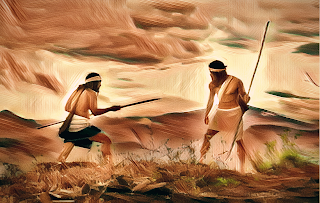- Ruata Lungchuang
Mizoram has been through multiple civil wars, the majority of them were not chronicled and are now forgotten. Nonetheless, the conflict between North and South Mizoram remains one of the bloodiest and most properly documented civil wars in Mizoram's history.
The "Chhim leh Hmar indo", or war of the North and South, was a three-year conflict between the people of Northern and Southern Mizoram. The conflict was centred on the Sailo confederacy, but it affected all of Mizoram's tribes and major Lals.
The majority of this war's records came from written accounts by Britishers and Mizo historians, who received their information through secondhand witnesses. The exact year of this conflict is unknown, although it is widely assumed that the Chhim leh Hmar Indo occurred between 1856 and 1859.
While raids and pillaging were prevalent among the Mizos, by the 1850s, several Mizo principalities had begun to abandon the habit of targeting neighbouring Mizo villages and Lals in favour of raiding Bengali and British settlements in the plains. The Sailos formed a loose confederacy led by a supreme Lal, while other great dynasties like the Lais and Fanais had their own systems and peace reigned in Mizoram. This was shortly after the end of another violent war between the Suktes of Burma and the Sailos, so war fatigue was widespread, and a truce or understanding among fellow Mizo tribesmen was more valued than mindless attacks and pillaging.
However, this uneasy calm was abruptly broken when two Sailo Lals quarrelled, resulting in the resurgence of raiding between fellow Mizos within Mizoram, which became even bloodier than the past.
A fight developed between the Southern Lal Lalpuithanga and the Vuta of the North, sparked by a song and disagreement about a boundary. According to the most common narrative, Vuta insulted Lalpuithanga with a song when Lalpuithanga allegedly gave up a portion of his territory. Lalpuithanga was deeply offended by this act and devised a scheme to repay him and humiliate Lal Vuta. When lal Vuta dispatched his men to ransom a particularly valuable gun from Lalpuithanga's village, Lalpuithanga confronted them and forced them to admit that their King had insulted him with a song. Lalpuithanga became even more upset when he saw Vuta's men openly admit to the accusation, and a gun was fired as Vuta's men were leaving his village ( A blank fire signals a declaration of war in Mzo culture).
And thus the battle between the North and the South began. All of the northern principalities, including the powerful Fanais, supported Vuta, while all of the southern principalities, including the uncontested Lais, supported Lalpuithanga. The war was one of the bloodiest in Mizoram's history, much more brutal than what the Mizos were used to.
There are several instances of entire villages being slaughtered and plundered; nonetheless, the Khawnglung Massacre remains one of the most discussed and retold stories of the conflict.
Khawnglung was one of the wealthiest and largest settlements in the south at the time, and it was attacked without warning by the northern Sailo ally the Fanais, who killed almost all of the men and took all of the children and women as slaves. The Khawnglung episode was immortalised among the Mizos by the oral romance Sanga of the love story between Chala and Thangi, two separated Khawnglung citizens. According to the narrative, Chala overcame great adversity to rescue Thangi from the Fanais who had imprisoned her.
The Southern principalities reacted quickly to the North's barbaric attack. The southern Sailos and the Lais destroyed numerous northern villages bordering the south. The southern rage was so intense that northerners equated Savegary with southern Mizos. In fact, it is thought that the disparaging name "pawi" associated with the Lais emerged during the North-South war.
According to legend, a Southern Lai Pasaltha was cornered by Northern Pasalthas. The stubborn Lai Pasaltha let out a battle cry stating that he was a leopard "Keima pawte," which Northerners unfamiliar with the Lai dialect misheard as "pawite," and the Lais and their kindred have been known as the Pawis or the pawites ever since.
There was no clear winner in the catastrophic three-year civil war, but southerners were thought to have fared slightly better than their northern counterparts. The Mautam famine of 1859 unexpectedly ended the fighting, and the civil war ended with no victor or truce.
The Chhim leh Hmar indo left an indelible mark on the Mizo community and Mizoram's culture. It significantly weakened Mizo states, which were quickly overrun by the British. The British further separated Mizoram into north and south Lushai hills, exacerbating the divide. The Church in Mizoram was also divided between North and South, therefore the legacy of the civil war not only influenced Mizoram's politics, but it also had a long-lasting impact on Mizo culture and became the most significant sociological division in Mizoram.
Northern Mizoram and southern Mizoram continue to have cultural and linguistic differences to this day. Despite the fact that the people are the same, it would not be incorrect to infer that there is still some bitterness and competition between the Presbyterian-dominated North and the Baptist-dominated South.
When one thinks of past conflicts and battles, it is easy to dismiss them as being in the past and having no importance in today's setting. However, the war between the North and Southern Mizoram demonstrates that events that occurred over two centuries ago have a lasting history and impact on present society.
Read about the Mizo Warrior Institution the Pasalthas here - The Mizo Pasaltha
ALSO EAD : The Actual Origin Of The Mizos
Mizo Contemporary History Needs Thorough Revision
The Mizos is an independent English language Digital Media from Mizoram and is in great need of support. Please consider donating to us and help us continue bringing Mizoram and NE news in English by offering small donations at our BUYMEACOFFE page - https://www.buymeacoffee.com/themizos


Ka lawm e
ReplyDelete